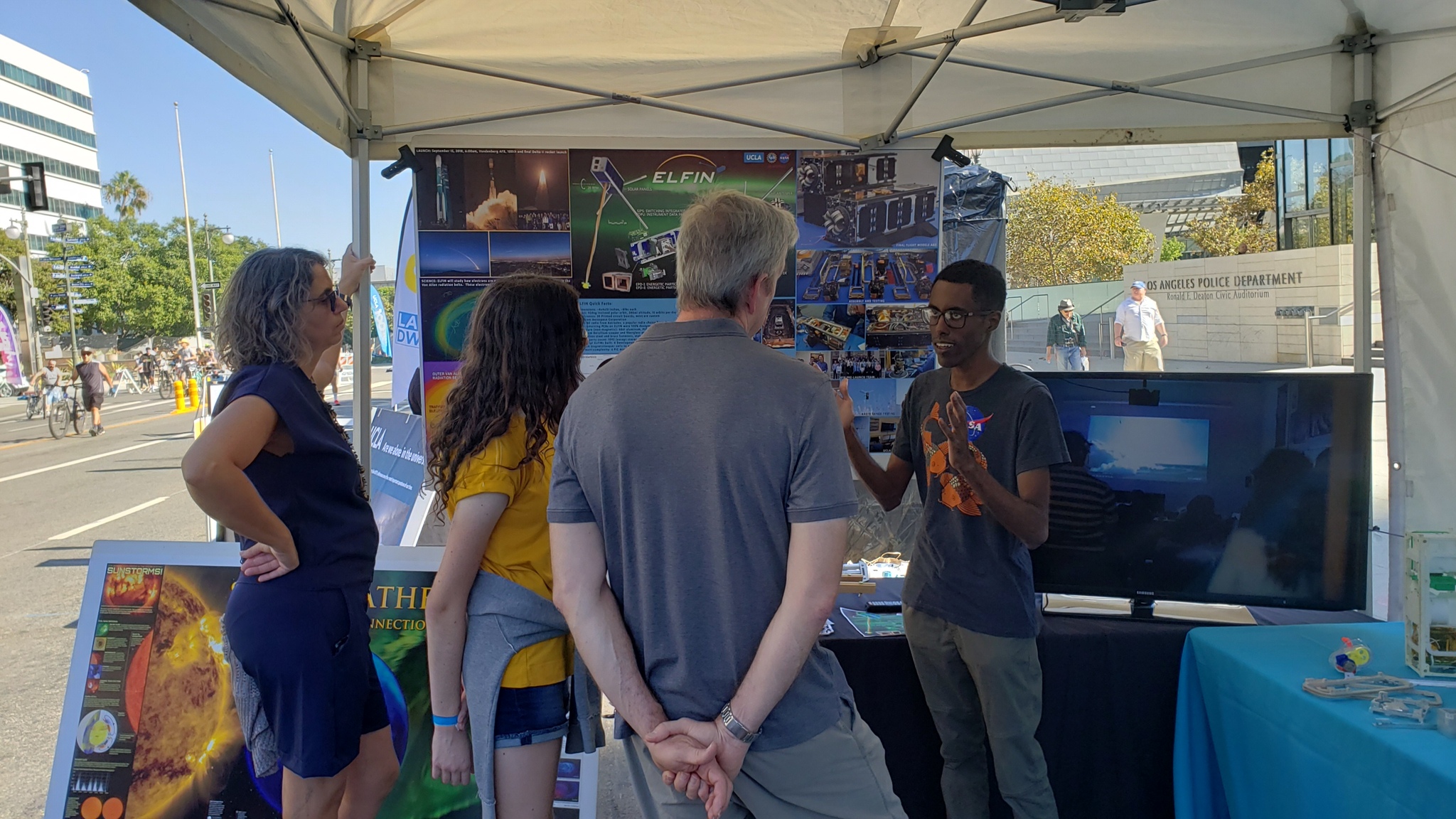 EPSS was featured at the popular event CicLAvia on Oct. 6, 2019, where miles of downtown LA streets were closed off for ~10,000 cyclists to ride freely. UCLA's Centennial celebration organized a huge exhibition in front of LA city hall for people to interact with UCLA history and present endeavors, and we were invited to represent EPSS and promote Exploring Your Universe with the Augmented Reality Sandbox, ELFIN CubeSat, and the GALE Lab. All of these booths were sustainably run by LADWP solar power. Thanks to our dedicated outreach volunteers, we reached well over a thousand people, many of them fellow Bruin alumni!
EPSS was featured at the popular event CicLAvia on Oct. 6, 2019, where miles of downtown LA streets were closed off for ~10,000 cyclists to ride freely. UCLA's Centennial celebration organized a huge exhibition in front of LA city hall for people to interact with UCLA history and present endeavors, and we were invited to represent EPSS and promote Exploring Your Universe with the Augmented Reality Sandbox, ELFIN CubeSat, and the GALE Lab. All of these booths were sustainably run by LADWP solar power. Thanks to our dedicated outreach volunteers, we reached well over a thousand people, many of them fellow Bruin alumni!
Taylor Dorn, a grad student in Prof. Mackenzie Day's Geomorphology and Aeolian Landscape Evolution (GALE) lab explained how wind erosion on Mars can give us clues about its past, which can teach us about Earth and other planets and moons. He also shared about his lab's role in the upcoming NASA Mars 2020 rover mission, which will land in Jezero Crater to examine evidence of how ancient water and wind flows sculpted the landscape.
Henry Gonzalez and Sourav Saha showcased the immersive AR Sandbox, used to teach undergrads about topographic maps in 3D. Kids of all ages packed the tent all day, digging in and building volcanoes, canyons, and islands, making it rain and seeing how water interacts with landforms. Everyone ooh-ed when we induced a "climate change" flood and saw the low lying areas turn into lakes, nothing beats hands-on experience.
 Last but not least, riders dismounted to interact with the tiny ELFIN CubeSat, UCLA's first satellite built and operated by students in EPSS. A popular selfie destination, visitors posed with a life-size (loaf-sized?) test model of the satellite, played with magnetic field demonstrations and a solar-magnetic motor, and saw the sun up close through a special solar telescope. A discussion about space weather wouldn't be complete without a space rock that fell to Earth! Visitors examined a rare metal-stony meteorite under a microscope, with shiny metal veins of iron and nickel resulting from shock-melting after an ancient impact in space (Bondoc P.I., 1956, donated by J.D. Hodder). Thanks to geophysics/space physics students Fik Beyene and Laura Iglesias, and alumni volunteers Mike Hartinger (SSI), and Reuben Rozario (SpaceX) for spending their Sunday in the sun for EPSS!!
Last but not least, riders dismounted to interact with the tiny ELFIN CubeSat, UCLA's first satellite built and operated by students in EPSS. A popular selfie destination, visitors posed with a life-size (loaf-sized?) test model of the satellite, played with magnetic field demonstrations and a solar-magnetic motor, and saw the sun up close through a special solar telescope. A discussion about space weather wouldn't be complete without a space rock that fell to Earth! Visitors examined a rare metal-stony meteorite under a microscope, with shiny metal veins of iron and nickel resulting from shock-melting after an ancient impact in space (Bondoc P.I., 1956, donated by J.D. Hodder). Thanks to geophysics/space physics students Fik Beyene and Laura Iglesias, and alumni volunteers Mike Hartinger (SSI), and Reuben Rozario (SpaceX) for spending their Sunday in the sun for EPSS!!
